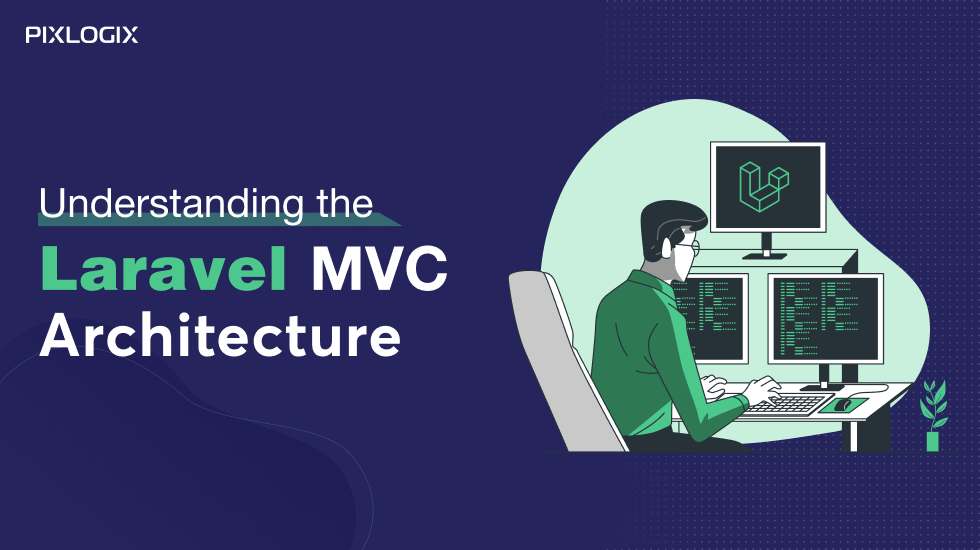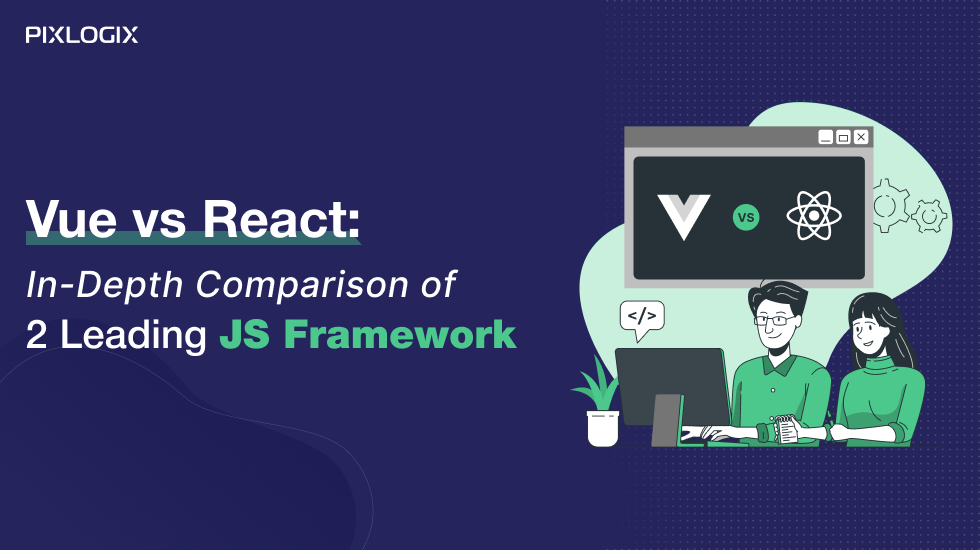Understanding the Laravel MVC Architecture

- Last Updated On December 18, 2024
- 11 min read
Do you feel that some PHP web apps look so amazing and how much effort they have to put into maintaining that type of web application? Well, frankly speaking, if you use Laravel to develop your web apps using PHP, you can save a lot of time and resources in developing your website and maintaining it.
Basically, Laravel is a very popular PHP framework that follows the Model-View-Controller AKA MVC architectural pattern. This powerful pattern provides a structured approach to building web applications, separating concerns, and promoting code reusability.
In this comprehensive guide, we will delve into Laravel MVC architecture, exploring its key components and the advantages that you get with this framework.
By understanding Laravel MVC architecture, developers can build modular and maintainable applications that are scalable and easy to collaborate on.
So, let’s continue reading and learn about how you can take advantage of this incredible framework for your business web apps.
An Overview of MVC (Model-View-Controller)
Model-View-Controller (MVC) is a software architectural pattern that has gained popularity in developing modern web applications. It provides a structured approach for separating the concerns of an application into three interconnected components: the Model, View, and Controller.
Each component has a specific role and responsibility within the application, facilitating better organization, maintainability, and code reusability.
Here is an overview of each component in the MVC pattern:
Model
The Model component of Laravel Architecture represents the application’s data and business logic. It encapsulates data access, manipulation, and validation. In simpler terms, it represents the application’s domain-specific data and the rules governing that data.
The Model component interacts with the database or other data sources to retrieve, store, and modify data. It is responsible for maintaining data consistency and integrity.
Related Post: Laravel – The Perfect PHP Framework for Startups
View
The presentation layer of the application comes under the View component. It defines how data is displayed to the user. Views are responsible for rendering the user interface, which may include HTML templates, CSS styling, and JavaScript interactivity.
Views can be dynamic, where they display data retrieved from the Model, or static, providing a fixed layout or content.
Controller
The Controller acts as an intermediary between the Model and View. It receives user input, processes it, and determines the appropriate actions to be taken. Controllers handle user requests, orchestrate the flow of data between the Model and View, and execute business logic.
They retrieve data from the Model, prepare it for presentation, and pass it to the View. Controllers also handle user interactions, such as form submissions or URL requests.
Now that you understand Laravel’s Model-View-Controller Architecture pattern, you might be thinking about how it will help your business. So, to know about why the Laravel platform is vital for your business, and how using Laravel MVC Architecture can provide advantages for your business.
Why Laravel MVC Architecture Matters for Businesses Like Yours?
Laravel MVC architecture offers several advantages that make it highly beneficial for businesses developing web applications. If you are planning to hire Laravel developers, understanding them also helps you in discussing the profitable possibilities for your business.
Here are some common reasons why Laravel MVC architecture matters for businesses:
#1: Code Reusability
Models can be reused across different parts of the application, allowing developers to avoid duplicating code. This not only saves development time but also reduces the risk of introducing bugs. With Laravel MVC architecture, businesses can leverage code reusability.
Models, views, and controllers can be reused across various parts of the application, reducing development effort and cost. This reusability also reduces the risk of introducing bugs, improves code consistency, and speeds up future development and maintenance tasks.
#2: Cost Efficiency
While the initial investment in adopting a framework like Laravel might involve a learning curve for developers, the long-term benefits in terms of development speed, maintainability, security, and code quality can make it a cost-effective choice for businesses building web applications.
#3: Quality Assurance
Laravel MVC architecture enhances testability, making it easier to write unit tests for each component. By testing models, views, and controllers independently, businesses can ensure the quality and reliability of their applications.
This leads to higher customer satisfaction, reduced bug-related issues, and increased confidence in the software.
#4: Organize Modular Code
Laravel MVC architecture promotes modular code organization by separating the application logic into distinct components. This makes it easier to manage and maintain the codebase, as each component has a specific role and can be modified or replaced independently.
#5: Separation of Concerns
MVC enforces the separation of concerns, ensuring that each component focuses on a specific task. Models handle data access and manipulation, views handle presentation and user interface, and controllers handle request processing and business logic.
This separation enhances code readability and maintainability.
#6: Enhanced Testability
Laravel MVC architecture makes it easier to test different components of the application. Models can be tested independently to ensure data integrity and business logic correctness.
Controllers can be tested for proper request handling and response generation, while views can be tested for the correct rendering of user interfaces.
#7: Scalability and Flexibility
MVC architecture provides a scalable and flexible foundation for Laravel applications. As the application grows, developers can easily extend the functionality by adding new models, views, and controllers without affecting existing components.
This scalability allows applications to adapt to changing business requirements.
#8: Improved Collaboration
By following a standardized architecture like MVC, developers can collaborate more effectively. The separation of concerns allows different team members to work on different components without interfering with each other’s work.
This promotes teamwork, reduces conflicts, and streamlines the development process.
#9: Rapid Development
Laravel MVC architecture provides developers with a clear structure and predefined patterns to follow. This accelerates the web development process as developers can focus on implementing specific components without having to worry about the overall architecture.
The availability of Laravel’s rich set of tools and features further boosts development speed.
#10: Increased Maintainability
With MVC, maintaining and updating the application becomes more manageable. The separation of concerns allows developers to modify or update a specific component without affecting the others.
This reduces the risk of introducing bugs and simplifies the debugging and troubleshooting process.
Related Post: Benefits of Laravel Development Services
#11: Code Understandability
Laravel MVC architecture enhances code understandability and readability. The separation of concerns makes it easier for developers to comprehend the functionality and purpose of each component.
This facilitates code reviews, onboarding new team members, and overall code comprehension.
#12: Long-term Maintenance and Upgradability
MVC architecture promotes the long-term maintainability of Laravel applications. With well-organized code and clear separation of concerns, businesses can easily make updates, and add new features without disrupting the entire application.
This reduces maintenance costs and ensures the longevity of the application.
#13: Community Support and Ecosystem
MVC architecture is widely adopted and has a thriving community of developers. This means there are ample learning resources, tutorials, and community support available for developers working with Laravel MVC architecture.
Additionally, Laravel’s ecosystem includes various packages and libraries that can be easily integrated into MVC-based applications, further enhancing their functionality and capabilities.
#14: Superior Upgradability
Like maintenance features, upgrading the Web Application is also a very messy task. But with the MVC you can get an upgradability facility for Laravel applications. This helps you in updating your Laravel application to the latest version without any hassle.
To sum up, we can say that Laravel MVC architecture matters for businesses because it provides a solid foundation for developing scalable, maintainable, and high-quality web applications.
By leveraging the benefits of Laravel MVC architecture, businesses can streamline development processes, enhance collaboration, reduce costs, and deliver reliable applications that meet their evolving needs.
Related Post: Laravel vs WordPress – Which one should you pick
Conclusion
Understanding Laravel MVC architecture is fundamental to developing robust web applications. By leveraging Laravel’s implementation of MVC, developers can benefit from code modularity, maintainability, and reusability.
In short, Laravel MVC architecture provides a solid foundation for building modern web applications. With a clear separation of concerns, reusable components, and a powerful routing system, Laravel enables developers to create high-quality applications with ease.
However, if you still have some queries related to Laravel or want to know the process of developing a Laravel Project, I recommend you to contact the best Laravel Development Company. When you hire Laravel developers, you can ensure to get an expert’s support.
You can contact the most trusted Laravel Development Company in India, Pixlogix Infotech Pvt. Ltd. with 15+ years of experience. This company offers you an excellent team of dedicated developers to provide you with flexible solutions.
For more details, you can directly call or mail and discuss your idea.
Samir Bhimbha
Samir Bhimbha is the Founder & CEO of Pixlogix Infotech Pvt. Ltd. which offers web and app solutions to fulfill business's online needs and help to improve their online presence with many clients in the USA, Europe, Australia, and more. He is a skilled entrepreneur, web designer, developer, and team leader who can handle every situation. With 15+ years of experience in UX/UI design and web development, he is leading a team of IT professional talents.
Related Post
Get in Touch Now!
Have a word with our expert consultants about your next project to get suggestive guidance & proposal.
Sales Inquiry
Chat with us about your project for a custom solution and quote.











